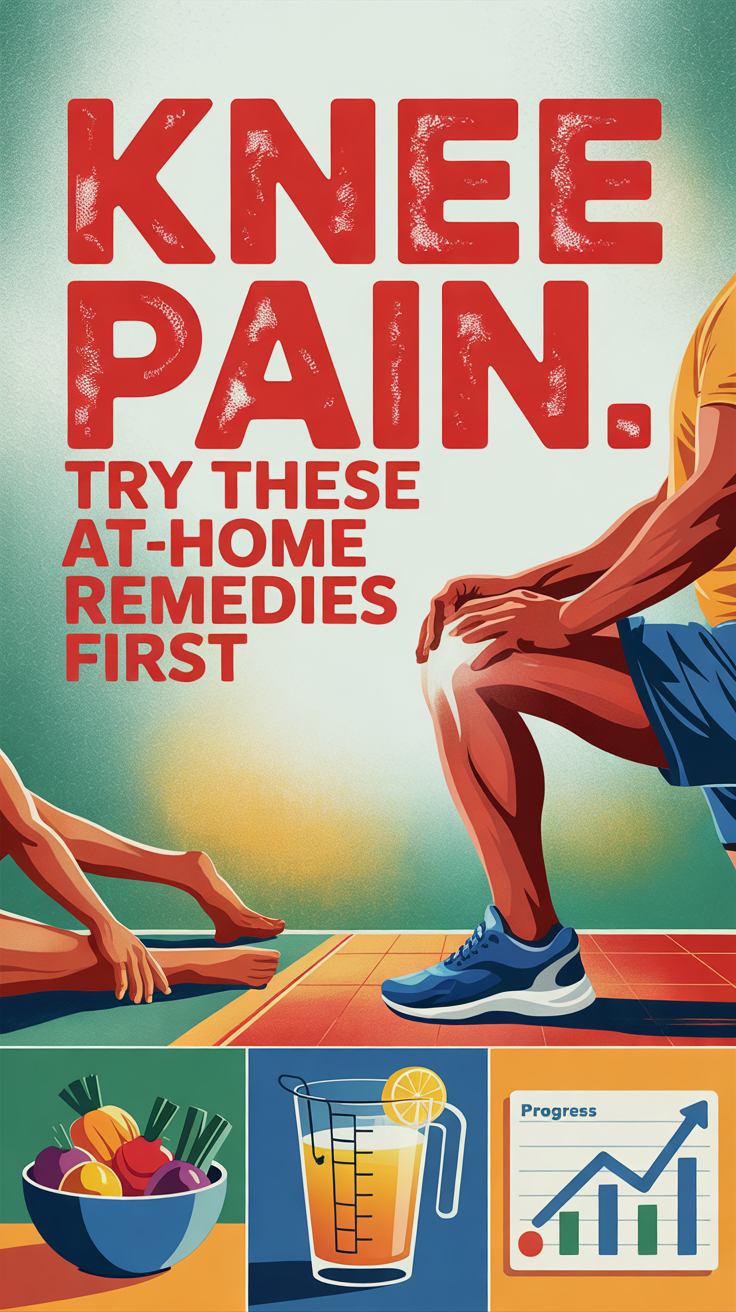Knee Pain. Try These At-Home Remedies First
Knee pain can disrupt your life, but you can try effective at-home remedies first. Use the RICE method—rest, ice, compression, and elevation—to reduce immediate discomfort. Once swelling subsides, applying heat can relieve tension and improve mobility. Engage in gentle exercises like leg lifts and bridges to strengthen your knees. Don’t forget dietary changes; incorporating anti-inflammatory foods can make a difference. Stay tuned to learn more about managing your knee pain effectively.
Understanding Knee Pain and Its Causes
Knee pain can be a daunting experience, often leaving you wondering about its underlying causes.
Factors like aging, injuries, and excessive stress from activities such as running or cycling can trigger discomfort. Conditions like arthritis or obesity further exacerbate the situation by putting additional pressure on your joints. Understanding these causes is crucial, as it’ll guide you in seeking effective knee pain relief remedies. Common problems like sprained ligaments and tendonitis can develop from overuse or trauma, making it even more important to be aware of the signs. Identifying the cause of your knee pain is essential for effective treatment, whether it’s adjusting your exercise routine, managing your weight, or incorporating gentle stretches; recognizing the specific origin of your pain can help you find the most suitable solutions tailored to your needs.
The RICE Method for Immediate Relief
When dealing with knee pain, immediate relief can often be found through a widely recognized method known as RICE.
This approach not only alleviates discomfort but also promotes healing. In addition, applying the RICE method immediately helps minimize swelling and speeds up your recovery.
Here’s how to apply RICE effectively:
- Rest: Halt activities that worsen the pain.
- Ice: Apply for 20-30 minutes to numb the area.
- Compression: Use a bandage to limit swelling, avoiding tightness.
- Elevation: Keep your knee above heart level.
- Duration: Use RICE consistently for the first few days to maximize benefits. Additionally, starting RICE protocol as soon as possible is crucial for effective recovery.
Harnessing the Power of Heat Therapy
How can heat therapy transform your experience with knee pain?
By relaxing muscles and increasing blood flow, heat therapy helps alleviate tension and stiffness. It effectively reduces pain and enhances joint mobility through its analgesic effects, making daily activities more manageable. You can use various methods, like hot packs, warm water soaks, or heat wraps, ensuring you apply heat after any swelling has subsided. Remember to limit sessions to 15-20 minutes and monitor temperature to avoid burns. Applying heat after swelling has subsided can promote healing by enhancing circulation. Additionally, heat therapy is beneficial for addressing pain caused by osteoarthritis as it helps ease stiffness in the affected areas.
Effective Home Exercises for Knee Strength
Strengthening the muscles around your knee is essential for maintaining stability and reducing discomfort.
Incorporate these effective exercises into your routine:
- Leg Lifts: Target your quadriceps and hip flexors.
- Bridges: Strengthen your glutes and hamstrings for better support.
- Clamshells: Enhance stability by working on hip abductors. These exercises align with the principle of low-impact movements that maintain fitness while protecting knee health.
- Wall Sits: Build endurance in quadriceps and hamstrings.
- Lunges: Improve balance while engaging multiple muscle groups.
These exercises not only promote strength but also help stabilize your knee, making daily activities easier. Engaging in a routine focused on flexibility and strength can significantly aid in knee recovery.
Be patient and consistent for the best results.
Dietary Changes to Alleviate Knee Pain
Incorporating effective exercises can significantly improve knee strength, but dietary choices also play a vital role in managing knee pain. Focus on antioxidant-rich fruits and vegetables like berries, citrus, and leafy greens to combat inflammation. Including calcium-rich dairy is crucial for maintaining bone density, which supports joint health and reduces the risk of pain during movement. Research shows that including omega-3 fatty acids from fatty fish, walnuts, and flaxseeds can suppress harmful cytokines. Spices like turmeric, ginger, and garlic can further reduce inflammation. Choose high-fiber whole grains and legumes for balanced protein and gut health, and consider low-fat dairy for bone support. Avoid refined grains and processed meats, as they may worsen inflammation. Adjusting your diet can make a meaningful difference in alleviating your knee pain.
When to Seek Professional Help
If you’re experiencing persistent or worsening knee pain, it’s crucial to seek professional help.
Significant knee swelling that doesn’t improve over time may indicate a more serious issue requiring medical evaluation.
Don’t overlook these symptoms, as prompt treatment can prevent further complications and help you regain mobility. Additionally, recognizing classic signs of inflammation in your knee can aid in determining the urgency of your visit to a healthcare provider.
Persistent or Worsening Pain
When does knee pain signal the need for professional help?
If you experience persistent or worsening pain, it’s crucial to seek medical evaluation.
Consider consulting a specialist if you notice:
- Difficulty performing daily tasks due to pain
- Fever accompanying your knee discomfort
- Changes in knee function, like locking or instability
- Pain lasting longer than a few weeks without improvement
- Previous injuries that haven’t healed properly
Addressing these signs early can prevent further complications and help identify underlying conditions, ensuring you receive the appropriate treatment for your knee pain.
Significant Knee Swelling
Knee swelling can often accompany persistent or worsening pain, and understanding its significance is vital for your health.
If you notice a sudden increase in size, similar to a grapefruit, or experience severe pain, it’s time to seek professional help.
Rapid swelling after an injury often signals a serious issue, such as a torn ligament.
If you see redness, warmth, or if swelling doesn’t improve with self-care, don’t wait.
Persistent symptoms may indicate underlying conditions that require diagnosis and treatment.
Always listen to your body; seeking medical advice can prevent further complications and aid recovery.








